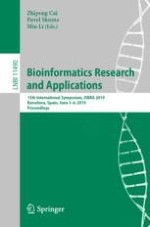2019 | Buch
Bioinformatics Research and Applications
15th International Symposium, ISBRA 2019, Barcelona, Spain, June 3–6, 2019, Proceedings
herausgegeben von: Zhipeng Cai, Dr. Pavel Skums, Min Li
Verlag: Springer International Publishing
Buchreihe : Lecture Notes in Computer Science
